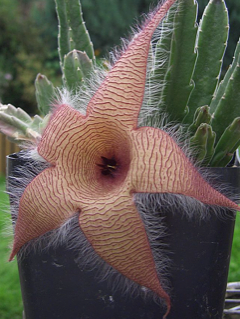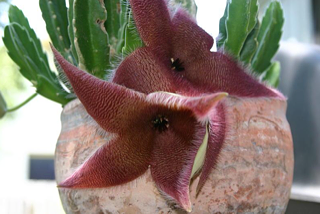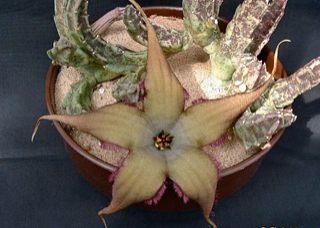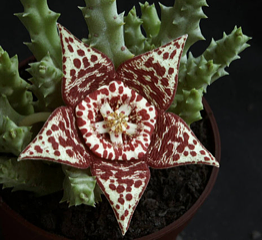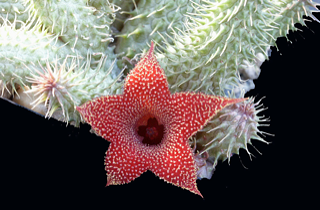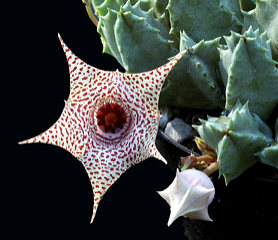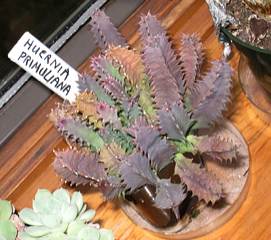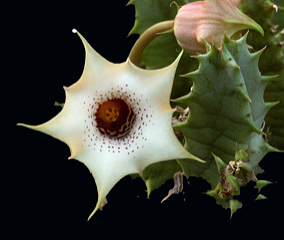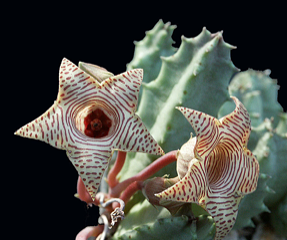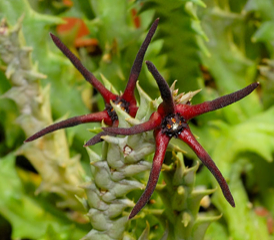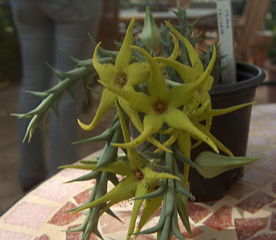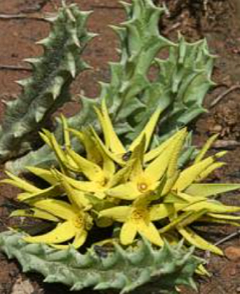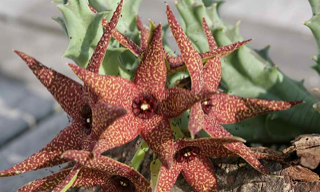Submitted by: Jim Tanner
Stapelia is a genus of low-growing, spineless, stem succulent plants, predominantly from South Africa with a few from other parts of Africa. Several Asian and Latin American species were formerly included but they have all now been transferred to other genera. The flowers of certain species, most notably Stapelia gigantea, can reach 41 cm (16 inches) in diameter when fully open. Most Stapelia flowers are visibly hairy and generate the odor of rotten flesh; a notable exception is the sweetly-scented Stapelia flavopurpurea. Such odors serve to attract various specialist pollinators including, in the case of carrion-scented blooms, blow flies of the dipteran family Calliphoridae. They frequently lay eggs around the coronae of Stapelia flowers, convinced by the plants’ deception.
The hairy, oddly textured and colored appearance of many Stapelia flowers has been claimed to resemble that of rotting meat, and this, coupled with their odor, has earned the most commonly grown members of the Stapelia genus the common name of carrion flowers.
A handful of species are commonly cultivated as pot plants and are even used as rockery plants in countries where the climate permits. Stapelia are good container plants and can grow well under full sun and light to moderate watering. They should be planted in well-drained compost as the stems are prone to rotting if kept moist for long.
The genus Huernia (family Apocynaceae, subfamily Asclepiadoideae) consists of stem succulents from Eastern and Southern Africa, first described as a genus in 1810. The flowers are five-lobed, usually somewhat more funnel or bell-shaped than in the closely related genus Stapelia, and often striped vividly in contrasting colors or tones, some glossy, others matt and wrinkled depending on the species concerned. To pollinate, the flowers attract flies by emitting a scent similar to that of carrion. The genus is considered close to the genera Stapelia and Hoodia. The name is in honor of Justin Heurnius (1587–1652) a Dutch missionary who is reputed to have been the first collector of South African Cape plants. His name was actually mis-spelt by the collector.
Various species of Huernia are considered famine food by the inhabitants of Konso special woreda in southern Ethiopia. The local inhabitants, who call the native species of this genus baqibaqa indiscriminately, eat it with prepared balls of sorghum; they note that baqibaqa tastes relatively good and has no unpleasant side-effects when boiled and consumed. As a result, local farmers encouraged it to grow on stone walls forming the terraces, where it does not compete with other crops.
Phylogenetic studies have shown the genus to be monophyletic, and most closely related to the Tavaresia genus, and to a widespread branch of stapeliads comprising the genera Orbea, Piaranthus and Stapelia.
Orbea variegata is a leafless, glabrous, clump-forming succulent perennial. The fourangled stems are usually prominently sharp-toothed, with a soft tip, grey green mottled purple in full sun. Each stem can reach over 10 inches. Starfish-like flower (has a light carrion smell), corolla 2 – 3 inches across, transversely ridged, pale greenish-yellow with dark purple-brown spots mostly in 6 – 7 rows or sometimes irregularly scattered, annulus pentagonal, 7/8 inch across, pale yellow with small dots, lobes of corona yellow, dusted or spotted purple. Smooth, cylindrical fruits, blotched and dotted purple, up to 4.7 inches long. Native to South Africa (Cape Province).
LATIN LOOKUP – Loquerisne Latine (Do you speak Latin)?
The meanings of latin plant names on this page – from http://davesgarden.com/guides/botanary/
- baldratii [bald-RAH-tee-eye]
For 20th century Italian plant collector Isaia Baldrati. - caudata [kaw-DAH-tuh]
With a tail. - gigantea [jy-GAN-tee-uh, gy-GAN-tee-uh]
Large, gigantic. - grandiflora [gran-dih-FLOR-uh]
With large flowers. - Huernia [hew-ERN-ee-uh]
Named for Justus Heurnius, 17th century Dutch missionary and botanist. - lutea [LOO-tee-uh]
Yellow. - Orbea [ORB-ee-uh]
From the Latin orbis, circular shape or disc. - piersii [PEERS-ee-eye]
For 20th century South African Government Surveyor, C. P. Piers. - primulina [prim-yoo-LEE-na]
Like a Primula. - quinta [KWIN-tuh]
Fifth; In reference to the fifth variety. - schinzii [SHINZ-ee-eye]
For 20th century Swiss botanist Dr. Hans Schinz. - Stapelia [sta-PEL-ee-uh]
Named for Johannes Bodaeus van Stapel, 17th century Dutch botanist and physician. - striata [stree-AH-tuh]
Striped or fluted. - variegata [var-ee-GAY-tuh]
Variegated.
